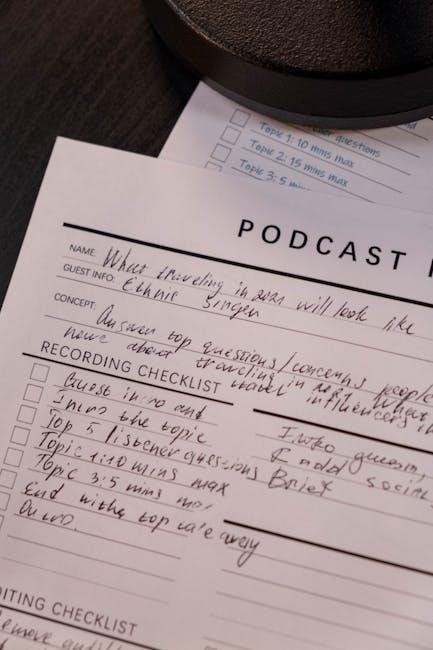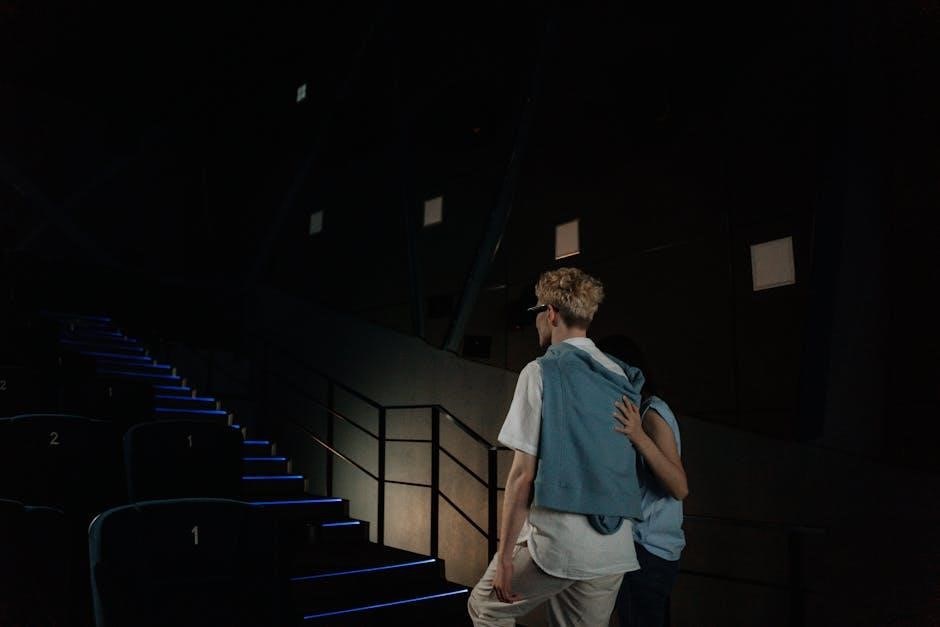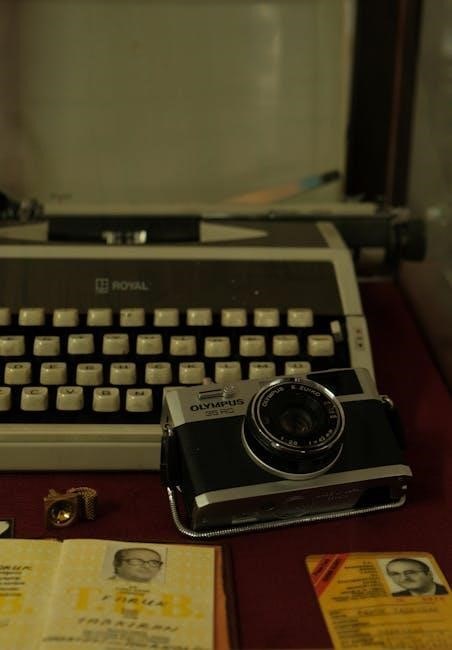
-
By:
- dane
- No comment
short guide to writing about film
Writing about film combines creativity and analysis, offering insights into storytelling, cinematic techniques, and cultural context. It engages audiences by exploring themes and emotional resonance effectively.
Understanding the Purpose of Film Analysis
Film analysis aims to deeply explore a film’s themes, techniques, and cultural context, helping viewers understand its artistic and emotional impact. By examining cinematic elements like camera angles, lighting, and sound, analysts uncover hidden meanings and evaluate storytelling effectiveness. This process also considers the director’s intent and societal influences, offering insights into how films reflect or challenge cultural norms. Effective analysis enhances critical thinking and appreciation for filmmaking craftsmanship, making it a valuable tool for both scholars and casual viewers. Ultimately, it bridges the gap between creator and audience, fostering a richer understanding of cinema’s power to inspire and provoke thought.
Key Elements of Effective Film Writing
Effective film writing requires a balance of descriptive and analytical techniques, capturing both the visual and emotional essence of a film. Clear and focused summaries are essential, ensuring readers grasp the film’s core themes and messages. Engaging audiences involves using vivid language and relatable examples, while avoiding overly complex jargon. Strong critical thinking is vital, as it allows writers to interpret cinematic techniques and their impact on the narrative. Additionally, incorporating research and context enhances depth, providing readers with a well-rounded understanding. By blending these elements, film writers can create compelling reviews and analyses that resonate with diverse audiences and inspire further exploration of cinema.

Preparing to Write About Film
Give films your undivided attention, analyzing clips and making detailed observations. Reflect on themes, techniques, and cultural context to develop insightful commentary and well-supported arguments;
How to Watch Films Critically
To watch films critically, start by analyzing the storyline for its structure and themes; Observe how the plot unfolds and identify any twists. Examine character development and interactions, noting how they reveal personality traits or the film’s message. Pay attention to cinematography, including camera angles, lighting, and color, which can influence the mood and emphasize certain elements. Listen to the soundtrack and sound effects, considering how they enhance the emotional impact of scenes. Study the editing techniques, such as pacing and scene transitions, to understand the film’s rhythm. Contextualize the film within its cultural and historical background, identifying references or symbols. Recognize the director’s unique style and how it compares to their other works. Take notes on standout scenes, quotes, or elements to aid in analysis. Consider the film’s genre and how it adheres to or challenges genre expectations. Reflect on your emotional response and the intended audience reaction. Finally, engage with external reviews to broaden your perspective, while maintaining your independent interpretation.
Researching the Film’s Context
Researching a film’s context involves understanding its historical, cultural, and social background to deepen your analysis. Start by identifying the time period and location in which the film was made, as these factors often influence its themes and tone. Investigate the director’s background, including their previous works and artistic style, to uncover recurring motifs or personal influences. Examine the cultural and political climate of the era, as films often reflect or challenge societal norms. Look into the production history, such as budget constraints, casting choices, and technological limitations, which can shape the final product. Additionally, explore the film’s genre and how it fits into or subverts genre conventions. Finally, review critical analyses and audience reactions from the time of its release to gain a broader perspective on its reception and significance.

Structuring Your Film Analysis
A well-structured film analysis includes an introduction, body, and conclusion. The introduction sets the tone, the body analyzes themes and techniques, and the conclusion summarizes insights.
The introduction of your film analysis should captivate readers while providing essential context. Begin with a compelling statement about the film’s title, director, and release year. Briefly mention its genre, cultural significance, or critical reception to establish relevance. Introduce your thesis statement, outlining the central argument or theme you’ll explore. Avoid spoilers but hint at the film’s emotional or intellectual impact. Keep your tone engaging and academic, setting the stage for a deeper exploration. Use this section to guide readers into your analysis, ensuring they understand the lens through which you’ll examine the film.
Body: Analyzing Themes and Techniques
In the body of your film analysis, delve into the film’s themes, exploring how they are developed through dialogue, visuals, and character development. Analyze cinematic techniques such as camera angles, lighting, and sound, explaining how they enhance the narrative or evoke emotions. Examine specific scenes or sequences that highlight the director’s intent or the film’s cultural significance. Use evidence from the film to support your interpretations, ensuring your analysis is both insightful and grounded. Avoid summarizing the plot; instead, focus on unpacking the film’s deeper meanings and artistic choices. This section should demonstrate your understanding of the film’s craft and its ability to communicate ideas or provoke thought.
In the conclusion of your film analysis, synthesize your key observations to reinforce your central argument. Restate the main themes and techniques you analyzed, highlighting how they contribute to the film’s overall impact. Avoid introducing new ideas; instead, focus on tying together the threads of your analysis. Offer a final perspective on the film’s significance, whether it’s its cultural relevance, artistic achievement, or emotional resonance. Keep your conclusion concise and impactful, ensuring it leaves the reader with a clear understanding of your stance. A strong conclusion should encapsulate the essence of your analysis, providing a satisfying closure to your written piece.

Common Cinematic Techniques to Analyze
Analyzing common cinematic techniques like camera angles, lighting, sound, and editing reveals how filmmakers convey mood, tone, and narrative depth, enhancing the storytelling experience.

Camera Angles and Movements
Camera angles and movements are essential tools in filmmaking, guiding the audience’s focus and emotions. A close-up emphasizes details, like facial expressions, while a wide shot establishes setting and context. Low-angle shots can convey power, whereas high-angle shots may evoke vulnerability. Movements such as pans and dolly shots create dynamic perspectives, while tracking shots follow action, immersing viewers. Analyzing these techniques helps uncover the director’s intent and the film’s emotional resonance. Understanding how these elements are used enhances your ability to interpret and critique cinematic storytelling effectively. Always consider how camera work influences the overall narrative and atmosphere in a scene.
Lighting and Color
Lighting and color are integral to shaping a film’s mood and atmosphere. High-key lighting reduces shadows, creating a bright, often upbeat tone, while low-key lighting emphasizes shadows, fostering drama or tension. Color palettes can evoke emotions, with warm hues like red and orange symbolizing passion or conflict, and cool tones like blue and green suggesting calmness or melancholy. Filmmakers often use color contrast to guide focus or highlight themes. Lighting direction, such as backlighting or soft lighting, can enhance depth or create a cinematic glow. Analyzing these elements reveals how they contribute to the narrative and emotional impact of a scene. Paying attention to lighting and color enriches your understanding of the film’s visual storytelling and artistic vision.
Sound and Music
Sound and music play a crucial role in enhancing a film’s emotional and narrative impact. Diegetic sound (originating from within the scene, like dialogue or ambient noise) and non-diegetic sound (like a soundtrack) work together to immerse the audience. Music, in particular, can evoke emotions, signal themes, or foreshadow events. Sound effects, such as footsteps or rustling clothes, add realism, while Foley art creates subtle, believable audio details. The soundtrack can heighten tension, evoke nostalgia, or underscore character development. Silence, too, is powerful, often used to build suspense or emphasize dramatic moments. Analyzing how sound and music complement visuals reveals how filmmakers craft mood and guide audience interpretation. Paying attention to these elements enriches your understanding of the film’s layered storytelling and emotional depth.
Editing and Pacing
Editing and pacing are essential elements in filmmaking, shaping the rhythm and flow of a story. Editing refers to how scenes are cut, arranged, and transitioned to create a cohesive narrative. Techniques like fast-paced cuts can heighten tension, while slow, lingering shots build drama. Pacing determines the speed at which the story unfolds, influencing audience engagement. A well-edited film guides viewers’ attention, emphasizing key moments and emotions. Transitions and cross-cutting can connect ideas or build suspense. The editor’s choices, such as continuity editing or montage, significantly impact the film’s tone and rhythm. Analyzing editing and pacing reveals how filmmakers control the audience’s emotional journey and maintain narrative momentum.

Writing a Film Review

A film review expresses your opinion on a movie, blending analysis with personal critique. It should capture the essence of the film while engaging readers.
Focus on key elements like plot, characters, and cinematography, supported by specific examples. Keep your tone clear and concise, ensuring your review is informative yet entertaining.
A strong introduction sets the tone for your film review, engaging readers and providing context. Begin with a hook—perhaps a thought-provoking quote, question, or insight—to grab attention. Briefly introduce the film, including its title, director, and release year, while avoiding spoilers. Clearly state your thesis or main argument about the film’s quality, themes, or impact. Use engaging language to reflect the tone of your review, whether formal or casual. Avoid vague statements and ensure your introduction flows logically, setting up the analysis to follow. Keep it concise, as the introduction should not overshadow the rest of the review. A well-crafted opening will draw readers in and prepare them for your critique.

Descriptive vs. Analytical Writing
Descriptive writing focuses on vividly portraying elements like scenes, characters, and settings, using sensory details to create a mental image. In film writing, it involves detailing cinematography, dialogue, and emotions to help readers visualize the story. Analytical writing, however, delves into interpretation, exploring themes, motifs, and the director’s intent. It examines how cinematic techniques convey meaning and contribute to the film’s message. Balancing both styles is crucial: descriptive writing grounds the analysis, while analytical writing provides depth and insight. Effective film critiques often blend these approaches to engage and inform readers, offering both a clear picture and a thoughtful exploration of the film’s elements. Mastering this balance enhances the quality and impact of your writing.
The conclusion of a film review or analysis should succinctly summarize your key insights and leave readers with a lasting impression. It’s an opportunity to reflect on the film’s overall impact, reiterating its strengths and weaknesses; Avoid introducing new points here; instead, synthesize your arguments to reinforce your perspective. Including a rating system (e.g., stars, grades, or recommendations) provides clarity and helps readers quickly assess your opinion. Be sure to justify your rating with specific examples from the film. A strong conclusion engages the audience, encouraging them to think critically about the movie and its themes. It should also invite further discussion, making your review memorable and impactful.
Advanced Tips for Film Writing
Enhance your analysis with nuanced observations, explore subtext, and use rhetorical devices to captivate readers. Connect films to broader cultural or historical contexts for deeper insights.

Engaging Your Audience
To captivate readers, use vivid descriptions and relatable analogies that bring films to life. Share personal insights and emotional reactions to create a connection. Pose thought-provoking questions to encourage reflection and debate. Use rhetorical devices like metaphors or humor to make your writing memorable. Avoid overly academic language and instead adopt a conversational tone that feels approachable. Highlight universal themes or moments that resonate with everyday experiences, making the film’s relevance clear. Balance critique with enthusiasm, showing genuine passion for the subject. By weaving storytelling techniques into your analysis, you’ll draw readers in and keep them invested in your perspective.
Avoiding Common Mistakes
When writing about film, steer clear of overanalyzing without clarity. Avoid excessive jargon that alienates readers unfamiliar with cinematic terms. Don’t neglect the film’s context, such as its historical background or cultural significance. Overly subjective critiques lacking evidence can undermine credibility. Refrain from spoilers, especially in reviews, to respect readers who haven’t seen the film. Avoid vague statements like “the film is good” without supporting details. Don’t ignore the director’s intent or the broader themes. Steer clear of comparing films excessively, as it distracts from your main analysis. Lastly, proofread to eliminate grammar and spelling errors. By sidestepping these pitfalls, you’ll craft a polished, engaging, and insightful piece that resonates with your audience.

Final Thoughts
Mastering film writing is a journey of continuous learning and refinement. Keep honing your skills, stay curious, and let your passion for cinema shine through your words.
Continuous Improvement in Film Writing
Continuous improvement in film writing requires dedication and a willingness to grow. Seek feedback from peers or mentors to refine your analysis and style. Regularly read exemplary film criticism to understand different approaches and techniques. Expand your cinematic knowledge by exploring diverse genres, directors, and eras. Practice writing reviews and analyses consistently, reflecting on what resonates with audiences. Stay updated on industry trends and emerging filmmakers to broaden your perspective. Engage in discussions about films to deepen your understanding and challenge your own viewpoints. Embrace constructive criticism and use it to enhance your craft. Over time, your unique voice and insightful analysis will set your writing apart.
Resources for Further Learning
To deepen your understanding of film writing, explore reputable resources like books, online courses, and websites. Books such as “The Filmmaker’s Handbook” by Steven Ascher and Edward Pincus provide technical insights, while “On Writing” by Stephen King offers tips on storytelling. Online platforms like MasterClass and Coursera offer courses on film analysis and screenwriting, taught by industry experts. Websites like The British Film Institute (BFI) and RogerEbert.com feature in-depth reviews and essays. YouTube channels such as Every Frame a Painting analyze films visually. These resources will help refine your skills, broaden your knowledge, and inspire your writing. Regularly engaging with them ensures you stay informed and grow as a film writer.